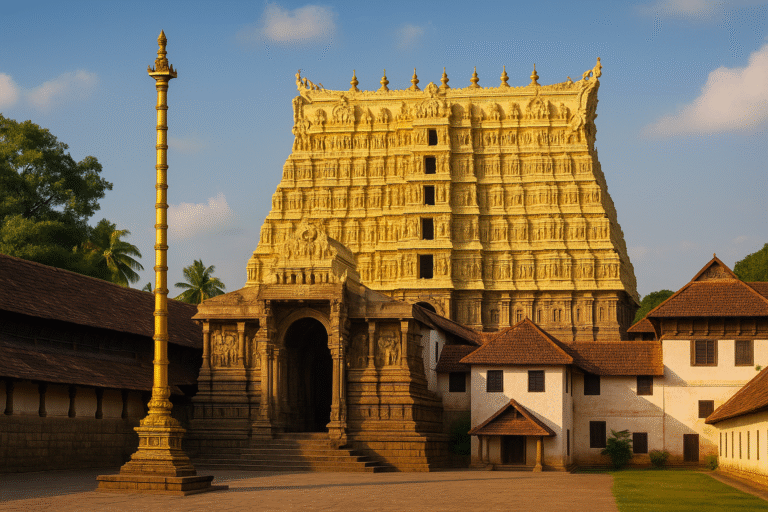
Tucked in the vibrant city of Thiruvananthapuram, Kerala, the Padmanabhaswamy Temple stands as one of India’s most enigmatic and historically rich Hindu shrines. Dedicated to Lord Vishnu, this architectural wonder is not just a place of worship—it is a living monument to dynastic devotion, ancient engineering, and mystical lore spanning over a millennium.
Ancient Origins and Mythical Roots
The earliest references to the temple are found in medieval Tamil texts and inscriptions dating back to the 8th–9th century CE, but local legends and religious traditions suggest it may be even older. Mythology links the temple to sages such as Divakara Muni, a great devotee of Vishnu, who is said to have had a divine vision that led to the temple’s creation.
Some historians also speculate that the site was a major Vishnu shrine during the Sangam period and possibly existed in a rudimentary form as early as the 3rd century CE.
The Temple and the Travancore Dynasty
The most significant phase of the temple’s transformation came during the 18th century, under the rule of King Anizham Thirunal Marthanda Varma, the visionary founder of the modern Travancore kingdom.
In 1750 CE, in a unique act of religious surrender, Marthanda Varma performed the “Thrippadidanam”—dedicating the entire kingdom to Lord Padmanabha. He declared himself and his successors as “Padmanabha Dasa” (servants of the Lord), making the deity the symbolic ruler of Travancore. This act had both spiritual and political consequences, linking the monarchy’s legitimacy to divine authority.
From this point, Travancore was ruled in the name of Lord Padmanabha, and royal policies were executed with a deep sense of religious duty. Temple administration, festivals, and rituals received royal patronage, which is evident in the temple’s expanding wealth and architectural grandeur.
Architectural Evolution
The temple’s construction evolved over centuries, incorporating Dravidian and indigenous Kerala architectural styles:
The seven-tiered gopuram (gateway tower) reflects Pandyan influence, added during the late medieval period.
Granite walls, courtyards, and inner sanctums show Kerala-style wood and laterite craftsmanship.
The sanctum houses the majestic idol of Lord Vishnu in the Ananthasayanam pose, lying on the serpent Adi Shesha, visible through three separate doors.
The idol, formed from 12,008 sacred shaligrams, is preserved using Katusarkara Yogam, an ancient Ayurvedic technique.
This blend of spiritual symbolism and engineering ingenuity showcases the temple’s architectural significance.
Padmanabhaswamy in Colonial and Post-Colonial India
Despite colonial pressures and changing regimes, the Travancore kings maintained their stewardship over the temple. The British, recognizing the religious sensitivity, generally refrained from interfering in the temple’s internal matters.
Post-independence, the temple remained under the management of the royal family, but in 2011, the Supreme Court of India intervened, prompting audits and legal proceedings regarding temple administration and its secret vaults.
The Hidden Vaults and Global Attention
In 2011, an inventory ordered by the Supreme Court led to the discovery of immense treasures stored in the temple’s underground vaults. Coins, gems, golden idols, ceremonial objects, and antique artifacts—valued at over $22 billion USD—shocked the world.
Vaults A through F were opened and inventoried.
Vault B, however, remains sealed, shrouded in legend. Local folklore warns that opening it may bring misfortune, invoking both religious reverence and cultural apprehension.
The hidden wealth raised debates about ownership, preservation, and the temple’s role as a custodian of history rather than a mere religious site.
Cultural and Religious Importance
The Padmanabhaswamy Temple is revered as one of the 108 Divya Desams, the most sacred abodes of Vishnu according to Vaishnava tradition. The temple rituals follow the Tantra Samuchayam and Vaikhanasa Agama, and access is restricted to Hindus only, preserving ancient practices.
Major festivals include:
Vishu and Onam – Celebrated with temple processions, music, and offerings
Navratri – Involves a royal procession of deities from across Travancore
Lakshadeepam – Held every six years, when 100,000 oil lamps illuminate the temple, symbolizing divine light
Conclusion: A Living Heritag
The Padmanabhaswamy Temple is not just an architectural marvel or a treasure trove—it is a living embodiment of India’s sacred history, dynastic legacy, and spiritual devotion. From mythical origins to modern court battles, from ritualistic tradition to global headlines, the temple continues to inspire awe and reverence.
In a fast-changing world, it stands as a timeless sanctuary, where faith, history, and heritage converge in the eternal gaze of Lord Padmanabha.